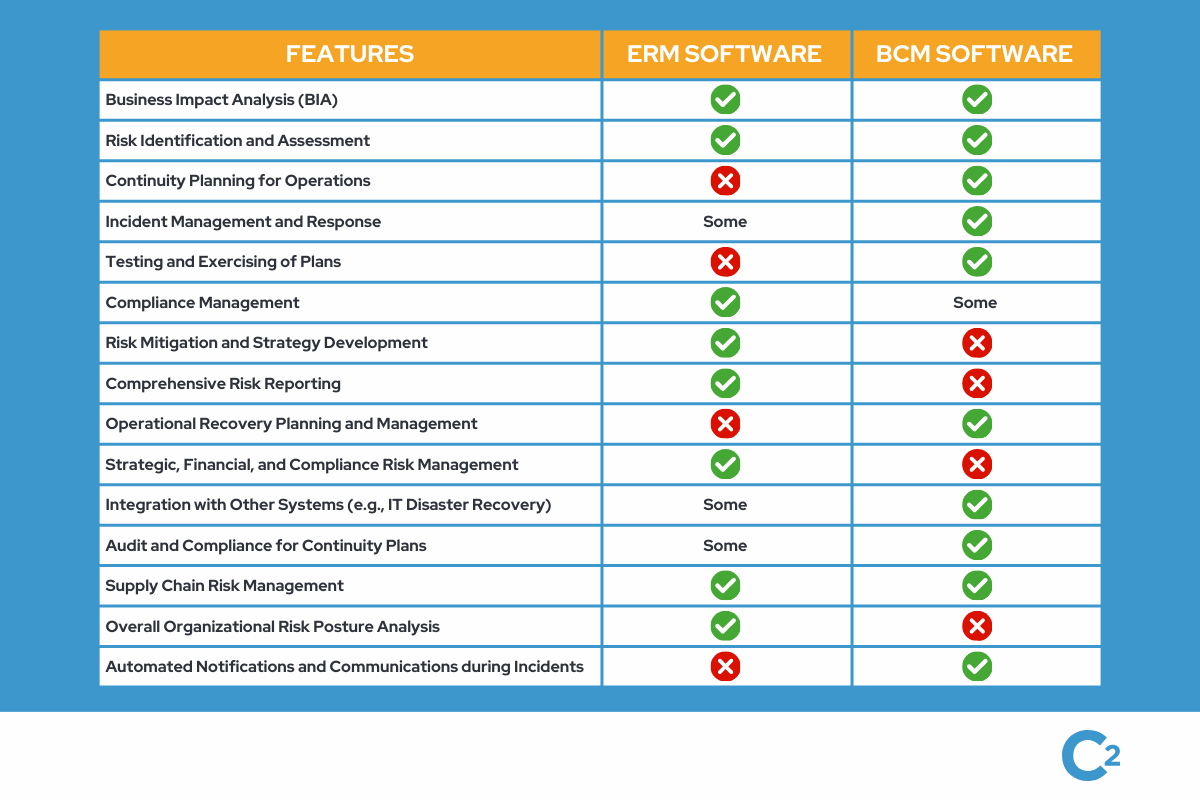Top 12 Enterprise Risk Management Software (ERM Software) for 2025
Published on February 08, 2024
Last updated on June 27, 2025
Jump to a section
According to Dataminr, 18% of risk leaders reported their current ERM strategies are effective or very effective in identifying, evaluating, monitoring, responding to, and communicating about risk. This underscores, now more than ever, the importance of understanding the role ERM software plays in implementing effective ERM strategies.
In this article, we are going to dive into what ERM software is, how risk professionals can utilise its key features to aid in developing and implementing ERM strategies, and which ERM software vendors to opt for. What's more, this is an opportunity for risk leaders to reevaluate the right kind of software that ultimately serves their organisational goals, growth, profitability, and resiliency.
Top 12 ERM Software for 2025
1. AuditBoard
2. Diligent
3. Fusion
4. IBM OpenPages
5. LogicGate
6. MetricStream
7. Mitratech EnterpriseInsight™
8. OneTrust
9. Resolver
10. Sprinto
11. Ventiv Technology
12. Workviva
Do you actually need ERM software?
What is ERM software?
Enterprise risk management software, or ERM software, is a specialised tool designed to assist organisations in identifying, assessing, and managing risks across various departments. It provides a holistic view of risk exposure, considering a wide array of risks (strategic, financial, operational, compliance, etc.) and how they interrelate. This enables companies to align their risk management strategies with their business objectives.
ERM software facilitates the collection and analysis of risk-related data, supports decision-making through risk assessments and reporting, and helps in monitoring compliance with regulatory requirements. In fact, 52% of risk leaders agree that organisations with an integrated approach to identifying, evaluating, and responding to incidents will lead to reduced exposure and better outcomes.
Aren't ERM software and risk management software the same thing?
While closely related in their objectives, enterprise risk management software and risk management software cater to somewhat different needs within the broader spectrum of risk management.
As mentioned earlier, ERM software is designed to help organisations identify, assess, monitor, and mitigate risks across all aspects of the enterprise. The holistic approach provides a comprehensive view of risk exposure, helping senior management make informed decisions that align with the company's risk appetite and strategic goals. ERM tools often include features for risk assessment, incident management, risk appetite and tolerance setting, dashboard reporting, and scenario planning.
Risk management software, in a narrower sense, might focus on specific categories of risks or the risk management process in certain operational areas, such as financial risks, IT risks, or health and safety risks. Risk management solutions are usually more specialised and may offer in-depth features tailored to the specific risk types, including risk identification, assessment, mitigation planning, and compliance management. They might not offer the broad, integrated view of all enterprise risks that ERM software provides, but instead offer more detailed functionalities for the specific risk categories they cover.
While there is overlap between ERM software and Risk Management software, the key difference lies in their scope and application. ERM software takes a bird's-eye view of risk across the entire organisation, aiming to align risk management with strategic objectives, while risk management software might focus more deeply on managing specific types of risks within particular operational domains.

Key considerations in selecting ERM software
Investing in ERM software represents a significant commitment for any organisation. You need to ensure that the investment delivers value and aligns with the company's overarching goals, especially when 20% of security and risk decision-makers indicated that the solutions their organisations use for risk management today are almost totally integrated with other business systems, according to Dataminr study.
Here's what to consider so you can maximise the value of your ERM software investment, turning it into a strategic asset that enhances your organisation's resilience and risk-aware culture.
- Alignment with Organisational Objectives and Risk Appetite: The ERM software should align with your organisation's strategic goals, risk appetite, and specific risk management requirements. It should support or can be configured to your risk management requirements in a manner that complements your organisational structure and business processes.
- Functionality and Scalability: Assess the software's capabilities to ensure it meets your current needs and can adapt to future requirements. Scalability is crucial to accommodate organisational growth and changes in risk exposure.
- Integration Capabilities: The software should easily integrate with existing systems and data sources within your organisation, such as financial systems, operational systems, and other business intelligence tools. Seamless integration facilitates comprehensive risk visibility and ensures data consistency across different departments and functions.
- User-Friendliness and Training Support: The ERM software should be intuitive and easy to use to encourage widespread adoption across the organisation. Adequate training and support from the vendor are essential to ensure users can leverage the software effectively. Consider the learning curve and the level of ongoing support and training resources available.
- Cost and Return on Investment (ROI): Evaluate the total cost of ownership, including initial purchase costs, implementation, training, and ongoing maintenance. Compare this against the expected benefits, such as improved risk visibility, better decision-making, compliance with regulatory requirements, and potential cost savings from mitigated risks. The chosen solution should offer a favourable ROI over a reasonable timeframe.
It's also important to assess the vendor's reputation, customer support services, and the software's compliance with relevant industry standards and regulations. Engaging with peer organisations and industry groups can provide valuable insights and feedback on different ERM software solutions.

Key features to look for in ERM software
While it's crucial to focus on features that align with your organisation's specific risk management needs and objectives, the right set of features can significantly enhance your ability to identify, assess, manage, and monitor risks effectively. Here are key ERM features to look out for.
- Risk Identification and Assessment: Look for software that offers comprehensive tools for identifying and assessing risks across various aspects of your organisation. This should include the ability to catalogue risks, assess their likelihood and impact, and prioritise them based on predefined criteria.
- Risk Mitigation Planning: The software should facilitate the development of risk mitigation strategies, allowing you to assign responsibilities, set timelines, and define actionable steps to address identified risks.
- Incident Management: The ability to record, track, and manage incidents and losses is crucial. This feature should enable the documentation of incidents, their investigation, and the implementation of corrective actions to prevent future occurrences.
- Risk Appetite and Tolerance Management: The software should help you define, communicate, and monitor your organisation's risk appetite and tolerance levels, ensuring that risk-taking activities align with strategic objectives.
- Scenario Analysis and Stress Testing: Advanced ERM solutions should offer capabilities for conducting scenario analyses and stress testing to evaluate the potential impact of various risk events on your organisation.
- Compliance Management: Ensure the software supports compliance management with relevant industry standards and regulatory requirements. This should include features for tracking compliance tasks, deadlines, and documentation requirements.
- Dashboard and Reporting: A user-friendly dashboard and robust reporting capabilities are essential for visualising risk data and generating actionable insights. Look for customisable dashboards and the ability to generate various reports to suit different stakeholders' needs.
Top 12 Enterprise Risk Management Software
Each of the following ERM software solutions brings unique strengths to the table, catering to different sizes and types of organisations, from startups to global enterprises, with specific industry needs. Here are, in alphabetical order, the 12 best ERM software vendors for 2025.
1. AuditBoard
Specialising in audit, risk, and compliance, AuditBoard is tailored for audit workflows and integrates efficiently with financial and IT systems, offering streamlined risk assessments and mitigation planning.
2. Diligent
Designed for large entities, Diligent offers a comprehensive ERM platform focusing on risk management, governance, and compliance. It stands out for its strong security measures – aligning with the NIST Cybersecurity Framework and adhering to ISO/IEC 27001 standards through an Information Security Management System (ISMS) – and scalable features, albeit at a premium price.
3. Fusion
Fusion excels in business continuity and crisis management alongside ERM. It's scalable, offers comprehensive risk program management, and provides intuitive tools for managing various risk aspects, making it suitable for large enterprises focused on continuity planning. While Fusion integrates well with internal systems, external integrations may require more development.
4. IBM OpenPages
IBM OpenPages is an AI-driven, highly-scalable GRC solution. It integrates well with IBM products and other enterprise systems, offering a wide range of risk and compliance management features.
5. LogicGate
Known for its flexibility, LogicGate allows customisable workflows for risk and compliance, making it ideal for businesses seeking tailored solutions. It offers automation, scalability, and advanced risk quantification methods, such as Monte Carlo simulations.
6. MetricStream
Known for its comprehensive governance, risk, and compliance (GRC) suite, MetricStream supports advanced risk assessments, integrates industry-standard control frameworks like COSO and COBIT, and includes AI-powered issue management to reduce redundancies.
7. Mitratech EnterpriseInsight™
Suitable for large organisations with complex legal and compliance needs, EnterpriseInsight™ provides a powerful platform for integrated risk management thanks to its pre-built risk assessment templates, supporting extensive enterprise system integration.
8. OneTrust
Focused on privacy, data governance, and compliance, OneTrust caters to organisations prioritising data privacy and security. The software offers streamlined data collection, risk categorisation, and real-time reporting. Regulations addressed by module include ISO 27001 and NIST Cybersecurity Framework.
9. Resolver
Incorporating best practices such as COSO, Resolver offers a robust risk management solution with strong incident management capabilities, integrating seamlessly with operational systems for enhanced risk visibility and incorporating automated workflows and business intelligence.
10. Sprinto
Sprinto is particularly focused on security compliance management, positioning it as a niche yet highly effective tool within its domain. Ideal for startups and mid-sized businesses, the software features distributed risk ownership, facilitating effective risk management across teams, and offers excellent cloud integration and customer support.
11. Ventiv (Riskonnect)
Now under Riskonnect, Ventiv offers advanced analytics and risk management tools suitable for complex organisational structures. It provides detailed audit trails, automated alerts, and integrated reporting, but has a steep learning curve. While it has a steep learning curve, Riskonnect compensates with extensive support and training.
12. Workviva
A versatile tool combining employee engagement with risk management, Workviva is best for SMEs. It boasts user-friendliness and integrates well with HR systems, providing an affordable solution with a focus on employee-centric risk approaches.
Do you actually need ERM software?
While ERM software provides key capabilities such as identifying, evaluating, monitoring, responding to, and communicating about risks, it's important to also consider aspects related to business continuity and operational resilience. These elements are crucial for ensuring that your organisation can withstand and quickly recover from disruptions.
Business continuity planning focuses on maintaining essential functions during and after a disaster has occurred, ensuring that the organisation can continue to operate or quickly resume its operations. This involves identifying critical business processes and the resources needed to support them, developing plans to manage disruptions, and regularly testing and updating these plans to ensure effectiveness.
Operational resilience then extends beyond business continuity to encompass the broader ability of an organisation to absorb and adapt to shocks, stresses, or adverse conditions without significant harm to its core operations, stakeholders, or reputation. It involves understanding the interconnectedness of various systems and processes within the organisation and the potential impact of external factors. Building operational resilience requires a holistic approach that includes not only preparing for known risks but also being adaptable and agile in response to unforeseen challenges.
ERM software vs Business Continuity Management software

Choosing the right software for your business
Integrating business continuity and operational resilience into the ERM framework enhances an organisation's overall risk management capabilities. Indeed, security and risk decision-makers from more mature organisations with more effective ERM strategies said their organisations were more likely to have implemented:
- 78% – cyber risk solutions
- 39% – threat and risk assessment tools
- 71% – safety and security mobile applications
- 44% – incident management
- 9% – real-time alerting tools
Unlike ERM software that may focus solely on risk aspects, our business continuity management software C2 Meridian integrates industry-agnostic modules and comprehensive features that address not just risk management (which is an exceptional stand-alone RMS in its own right), but also the critical aspects of business continuity and operational resilience.
This integration ensures that organisations have access to a wide range of tools necessary for effective enterprise risk management, business continuity, and operational resilience within a single platform. As a result, organisations are not only prepared to manage risks but also equipped to maintain essential functions and swiftly recover from disruptions, thus securing their long-term sustainability and success.
Book a demo today and see for yourself how C2 Meridian can transform your overarching risk management goals.
Written by Richard McGlave
Founder & CEO at Continuity2
With over 30 years of experience as a Business Continuity and Resilience Practitioner, Richard knows the discipline like the back of his hand, and even helped standardise BS25999 and ISO 22301. Richard also specialises in the lean implementation of Business Continuity, IT Service Continuity and Security Management Systems for over 70 organisations worldwide.


Written by Richard McGlave
Founder & CEO at Continuity2
With over 30 years of experience as a Business Continuity and Resilience Practitioner, Richard knows the discipline like the back of his hand, and even helped standardise BS25999 and ISO 22301. Richard also specialises in the lean implementation of Business Continuity, IT Service Continuity and Security Management Systems for over 70 organisations worldwide.